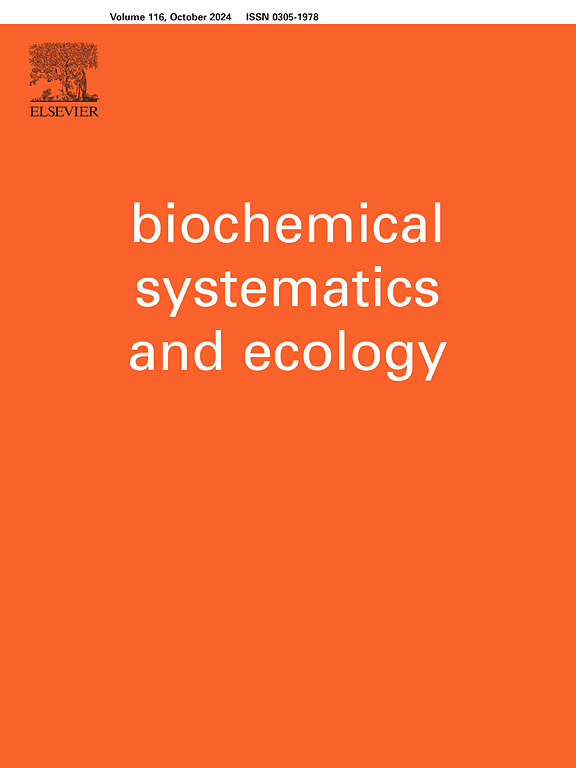Drying-induced changes in terpenoid composition in Rhododendron anthopogon leaves
IF 2
4区 生物学
Q4 BIOCHEMISTRY & MOLECULAR BIOLOGY
引用次数: 0
Abstract
To access the drying impact on essential oil of Rhododendron anthopogon D. Don, leaves of the species were collected from alpine meadows of Tungnath (Uttarakhand Himalaya, India). Both the fresh and shade dried leaves were used for oil extraction through hydrodistillation method. The results showed that α-Humulene was the most abundant compound, accounting for 25.6 % and 21.23 % in fresh and dried leaves, respectively, followed by α-pinene (24.9 % and 19.6 %, respectively. Other compounds also showed notable amounts, such as 2-β-pinene (7.71 % and 4.85 % in fresh and dried leaves, respectively) and trans-caryophyllene (5.12 % and 6.40 %, respectively). Analysis also revealed that nonadecane, p-menth-1-en-8-ol, β-citronellol, and trans-carane were present only in the essential oil extracted from dried leaves. The results indicated that, the biosynthesis of terpenoids in R. anthopogon responded differently to leaf drying. The production of sesquiterpenoids and triterpenoids, as well as phenylpropanoids was unaffected by the drying process, continuing at similar levels in both fresh and dried leaves. However, the biosynthesis of terpenoid backbone was only detectable in the essential oil from dried leaves. The selective activation of metabolic pathways observed in response to desiccation stress highlights the potential for significant alterations in the essential oil's chemical composition and biological properties. Further research is required to elucidate the precise molecular mechanisms and environmental factors mediating this phenomenon.

干燥对杜鹃叶片萜类成分的影响
为了研究干燥对东杜鹃(Rhododendron anthopogon D. Don)挥发油的影响,在印度北阿坎德邦(Uttarakhand)的Tungnath高山草甸采集了该物种的叶子。以鲜叶和阴干叶为原料,采用加氢蒸馏法进行油脂提取。结果表明,鲜叶和干叶中α-葎草烯含量最高,分别占25.6%和21.23%,其次是α-蒎烯,分别占24.9%和19.6%。2-β-蒎烯在鲜叶和干叶中分别占7.71%和4.85%,反式石竹烯在鲜叶和干叶中分别占5.12%和6.40%。分析还发现,壬烷、对月-1-烯-8-醇、β-香茅醇和反式烷烃仅存在于从干叶中提取的精油中。结果表明,不同干燥条件下,冬冬萜类化合物的生物合成有不同的响应。倍半萜类和三萜类以及苯丙素的生产不受干燥过程的影响,在新鲜和干燥的叶子中继续保持相似的水平。然而,萜类主链的生物合成仅在干叶精油中检测到。在干燥胁迫下观察到的代谢途径的选择性激活强调了精油的化学成分和生物学特性发生重大变化的可能性。需要进一步的研究来阐明精确的分子机制和介导这种现象的环境因素。
本文章由计算机程序翻译,如有差异,请以英文原文为准。
求助全文
约1分钟内获得全文
求助全文
来源期刊

Biochemical Systematics and Ecology
生物-进化生物学
CiteScore
3.00
自引率
12.50%
发文量
147
审稿时长
43 days
期刊介绍:
Biochemical Systematics and Ecology is devoted to the publication of original papers and reviews, both submitted and invited, in two subject areas: I) the application of biochemistry to problems relating to systematic biology of organisms (biochemical systematics); II) the role of biochemistry in interactions between organisms or between an organism and its environment (biochemical ecology).
In the Biochemical Systematics subject area, comparative studies of the distribution of (secondary) metabolites within a wider taxon (e.g. genus or family) are welcome. Comparative studies, encompassing multiple accessions of each of the taxa within their distribution are particularly encouraged. Welcome are also studies combining classical chemosystematic studies (such as comparative HPLC-MS or GC-MS investigations) with (macro-) molecular phylogenetic studies. Studies that involve the comparative use of compounds to help differentiate among species such as adulterants or substitutes that illustrate the applied use of chemosystematics are welcome. In contrast, studies solely employing macromolecular phylogenetic techniques (gene sequences, RAPD studies etc.) will be considered out of scope. Discouraged are manuscripts that report known or new compounds from a single source taxon without addressing a systematic hypothesis. Also considered out of scope are studies using outdated and hard to reproduce macromolecular techniques such as RAPDs in combination with standard chemosystematic techniques such as GC-FID and GC-MS.
 求助内容:
求助内容: 应助结果提醒方式:
应助结果提醒方式:


